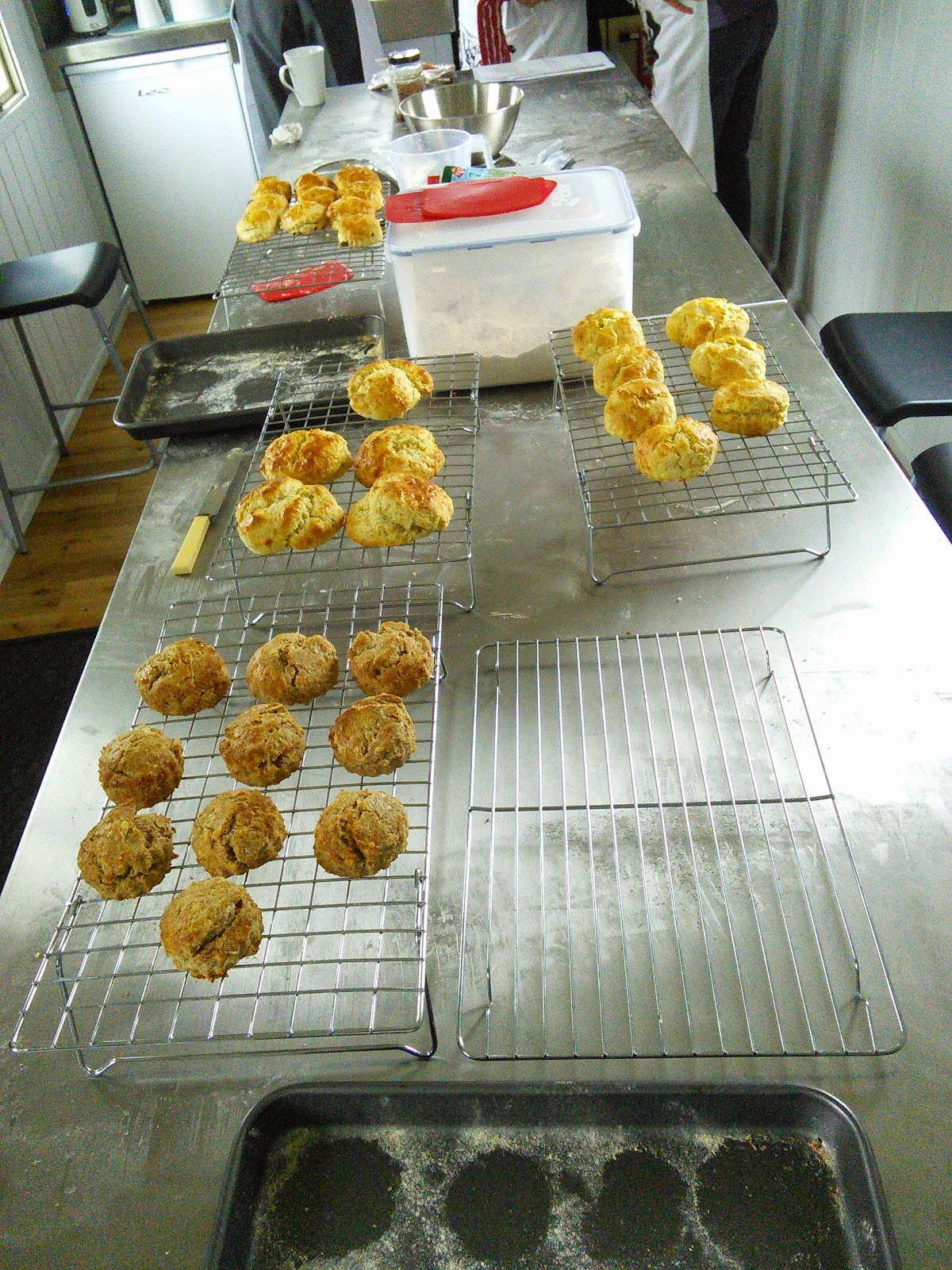This recipe produces a particularly sticky dough, and quite a lot of "dusting" was required at the loaf-shaping stage. The flexible dough scrapers are a godsend at times like this.
Everybody stayed cool despite the trickiness of the recipe and all the loaves went into their respective tins looking pretty good. The rolling up into a swiss roll shape that had seemed completely out of the question to me last week was successfully negotiated by everyone, and we even saw a couple of couronnes being shaped in round tins.
Anxious moments before taking the loaves out of the oven.
Fruit scones and cheese scones
While the bread was resting, there was time for scones. The weighing out was a serious affair, with cheese for the scones being grated to the nearest gram.
By the time the butter was being rubbed in, the chortling had begun.
It wasn't long before the jokes started. What's the fastest teacake? Scone!
Scone making styles were many and varied, and the results all looked and tasted quite distinctive.

Correction
I mentioned last time that the biggest problem we faced seemed (imho) to be following the recipe. In a moment of enlightenment this week, I learned that the real problem was that I had been following one recipe while everyone else was doing another!
Last week's loaf was relatively straightforward, with a shot of sun dried tomatoes incorporated into a dough enriched with olive oil. But this week's involved a (flour and water) sponge, a tomato sponge, tomato puree, sun dried tomatoes, onions, toasted sunflower seeds. I on the other hand, having already done all the tomato stuff last week. rolled up at the shepherd's hut with plenty of sponge and no tomatoes. Heigh ho.
Ask a man to follow a set of instructions...
... and you can expect a pickle.
Notes from Palestine
Our special correspondent Bouran has sent us some really interesting thoughts about Palestinian bread this week. Here is just a taste of what she has to say about yeast and water.
Yeast
At the mill we have been thinking about the difference between commercial yeast and the wild yeast in sourdough cultures. And we've touched on the temperature of the water we make the dough with. On a nice warm day we noticed that dough resting in direct sunlight seemed to rise very happily. But in England we don't have the luxury (or challenge, depending on your point of view) of such high temperatures in the summer that we have to actively control the amount of yeast. Here's Bouran on yeast -
"As for the amount of yeast, it usually varies depending on the weather condition and the season so generally less yeast in the hot summer days, and bit more in winter."
Water - wetter is better if it feels better
This is probably the hottest topic in the bread group: how wet should the dough be? We haven't been particularly strict with ourselves about this, although we have tried to follow the recipes accurately. And we certainly haven't worked out the "hydration" percentage - the ratio of the weight of the wet ingredients to the weight of the dry ingredients. I am very happy to find that Bouran describes pretty much exactly what I do with my dough -
"Now here comes the issue of how much water! Well I never measure to be honest. I just pour in enough water to combine the flour and get it altogether then gradually I start to add more little by little as I am kneading until I FEEL the dough has become soft and smooth. My idea is to train myself to the feel of the dough until I get it right. But that is just probably true in the case of pita bread only."More from Bouran next time.
Various sponges
Soapey Sponge is a rogue who appears in a couple of books by R. S. Surtees. He is full of hot air and a very tricky customer to deal with. A bit like a sourdough sponge, in fact. Here he is resting in a warm place, wondering where his next feed is coming from. Definitely like a sourdough sponge!
Unbeknown to Mr Sponge, the butler is also up to no good.
My sponges this week were completely above board.
 |
| White sourdough sponge |
 |
| Yeasted wholemeal wheat sponge |
The recipe we were following (some closer than others) said you should use yeast when making your sponge, and didn't say you should add any more yeast when adding the rest of the flour. This was interesting, because I had always thought extra yeast was needed because the yeast in the sponge would be exhausted by the time you came to make bread with it.
This picture shows that the dough using the yeasted sponge (on the right) did indeed rise nicely without any extra yeast, The dough using the sourdough sponge (on the left) hd some yeast added and grew more strongly.
It's always a balancing act between more or less yeast, and / or more or less time, and it's nice when it turns out right.
The happy ending
My babies turned out nicely, not least because instead of dusting the peel with polenta or breadcrumbs, I turned the dough out of the baskets onto a piece of baking parchment, which made sliding them into the oven as easy as pie. A neat trick I picked up from YouTube.












No comments:
Post a Comment